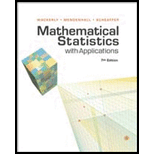
Concept explainers
Refer to Exercises 4.141 and 4.137. Suppose that Y is uniformly distributed on the interval (0, 1) and that a > 0 is a constant.
- a Give the moment-generating
function for Y. - b Derive the moment-generating function of W = aY. What is the distribution of W? Why?
- c Derive the moment-generating function of X = −aY. What is the distribution of X? Why?
- d If b is a fixed constant, derive the moment-generating function of V = aY + b. What is the distribution of V? Why?
a.
Find the moment-generating function for Y.
Answer to Problem 142E
The moment-generating function of Y is
Explanation of Solution
Let Y be a random variable that has a uniform distribution on the interval
The probability density function of Y is given by
The moment-generating function of Y is derived below:
Thus, the moment-generating function of Y is
b.
Find the moment-generating function of
Find the distribution of W.
Answer to Problem 142E
The moment-generating function of W is
The distribution of W is uniform distribution on the interval
Explanation of Solution
The moment-generating function of
Thus, the moment-generating function of W is
Hence, by the uniqueness theorem of mgf, the distribution of W is a uniform distribution on the interval
c.
Derive the moment-generating function of
Find the distribution of X.
Answer to Problem 142E
The moment-generating function of X is
The variable X is a uniform distribution on the interval
Explanation of Solution
The moment-generating function of
The moment- generating function of X is
This indicates that the variable X is a uniform distribution on the interval
d.
Derive the moment-generating function of
Find the distribution of V.
Answer to Problem 142E
The moment-generating function of V is
The variable V is a uniform distribution on the interval
Explanation of Solution
The moment-generating function of
The moment-generating function of V is
This indicates that the variable V is a uniform distribution on the interval
Want to see more full solutions like this?
Chapter 4 Solutions
Mathematical Statistics with Applications
- Let X be a random variable with support SX = {−3, 0.5, 3, −2.5, 3.5}. Part ofits probability mass function (PMF) is given bypX(−3) = 0.15, pX(−2.5) = 0.3, pX(3) = 0.2, pX(3.5) = 0.15.(a) Find pX(0.5).(b) Find the cumulative distribution function (CDF), FX(x), of X.1(c) Sketch the graph of FX(x).arrow_forwardA well-known company predominantly makes flat pack furniture for students. Variability with the automated machinery means the wood components are cut with a standard deviation in length of 0.45 mm. After they are cut the components are measured. If their length is more than 1.2 mm from the required length, the components are rejected. a) Calculate the percentage of components that get rejected. b) In a manufacturing run of 1000 units, how many are expected to be rejected? c) The company wishes to install more accurate equipment in order to reduce the rejection rate by one-half, using the same ±1.2mm rejection criterion. Calculate the maximum acceptable standard deviation of the new process.arrow_forward5. Let X and Y be independent random variables and let the superscripts denote symmetrization (recall Sect. 3.6). Show that (X + Y) X+ys.arrow_forward
- 8. Suppose that the moments of the random variable X are constant, that is, suppose that EX" =c for all n ≥ 1, for some constant c. Find the distribution of X.arrow_forward9. The concentration function of a random variable X is defined as Qx(h) = sup P(x ≤ X ≤x+h), h>0. Show that, if X and Y are independent random variables, then Qx+y (h) min{Qx(h). Qr (h)).arrow_forward10. Prove that, if (t)=1+0(12) as asf->> O is a characteristic function, then p = 1.arrow_forward
- 9. The concentration function of a random variable X is defined as Qx(h) sup P(x ≤x≤x+h), h>0. (b) Is it true that Qx(ah) =aQx (h)?arrow_forward3. Let X1, X2,..., X, be independent, Exp(1)-distributed random variables, and set V₁₁ = max Xk and W₁ = X₁+x+x+ Isk≤narrow_forward7. Consider the function (t)=(1+|t|)e, ER. (a) Prove that is a characteristic function. (b) Prove that the corresponding distribution is absolutely continuous. (c) Prove, departing from itself, that the distribution has finite mean and variance. (d) Prove, without computation, that the mean equals 0. (e) Compute the density.arrow_forward
- 1. Show, by using characteristic, or moment generating functions, that if fx(x) = ½ex, -∞0 < x < ∞, then XY₁ - Y2, where Y₁ and Y2 are independent, exponentially distributed random variables.arrow_forward1. Show, by using characteristic, or moment generating functions, that if 1 fx(x): x) = ½exarrow_forward1990) 02-02 50% mesob berceus +7 What's the probability of getting more than 1 head on 10 flips of a fair coin?arrow_forward
 Glencoe Algebra 1, Student Edition, 9780079039897...AlgebraISBN:9780079039897Author:CarterPublisher:McGraw Hill
Glencoe Algebra 1, Student Edition, 9780079039897...AlgebraISBN:9780079039897Author:CarterPublisher:McGraw Hill Trigonometry (MindTap Course List)TrigonometryISBN:9781337278461Author:Ron LarsonPublisher:Cengage Learning
Trigonometry (MindTap Course List)TrigonometryISBN:9781337278461Author:Ron LarsonPublisher:Cengage Learning
 Big Ideas Math A Bridge To Success Algebra 1: Stu...AlgebraISBN:9781680331141Author:HOUGHTON MIFFLIN HARCOURTPublisher:Houghton Mifflin Harcourt
Big Ideas Math A Bridge To Success Algebra 1: Stu...AlgebraISBN:9781680331141Author:HOUGHTON MIFFLIN HARCOURTPublisher:Houghton Mifflin Harcourt



